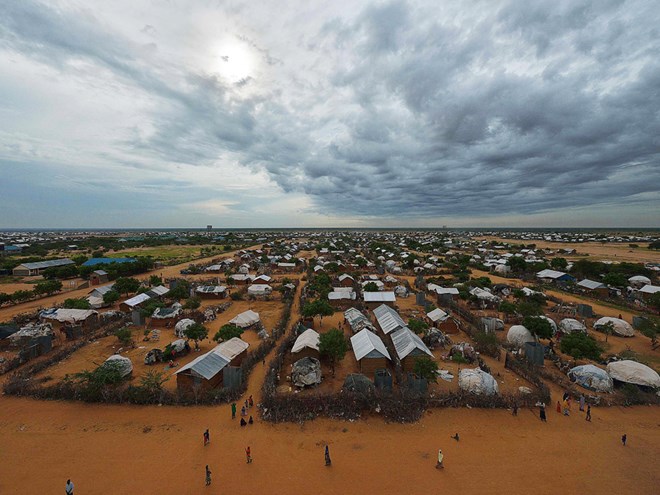
Thursday January 14, 2016

Dadaab was setup in 1991 to hold 80,000 refugees from the Somali civil war. But new residents joined them, from Somalia, Sudan, Congo, Ethiopia, Uganda and Rwanda, until Dadaab — now at nearly half a million people — became "a giant cosmopolitan city made of mud tents and thorns."
By the time Ben Rawlence made his first trip to Dadaab — the world’s largest refugee camp, in northeast Kenya — he thought he knew what to expect. At the time, Rawlence, a former British political aid, was working as a researcher for Human Rights Watch, an organization that has for years used refugee camps to access and interview the victims of war crimes.But what struck Rawlence about Dadaab, it turned out, were not the horror stories, of misery and rape and violence, as horrible as they might have been. “It was these people who had never left,” he said. “It was the soccer leagues. It was the primary school. It was the market.” It was, in other words, normal life in that abnormal place, that temporary world made somehow permanent.
Not long after his first visit, Rawlence took a leave from Human Rights Watch; he eventually quit entirely to focus on a new project. Over the next four years, he made five more trips to Dadaab. In total, he spent about five months in the sprawling camp, which stretches over 78 square kilometers and was home, by the end of 2015, to nearly half a million people.The product of those visits is City of Thorns, a book about nine more or less typical lives in Dadaab. Over the years, Rawlence followed a group of, mostly young, men and women, through marriages, births, famine, and more. He wrote about their hopes, their hustles and the seemingly intractable problems they faced.
City of Thorns, released last week, hit shelves at a moment of rare prominence for refugee issues. It landed amid ongoing political debates in Europe, the Middle East, the United States and Canada over what to do with the historic flow of refugees fleeing the Syrian civil war.
It is, on one level, a cautionary tale. Dadaab was setup in 1991 to hold 80,000 refugees from the Somali civil war. But over the years, as that conflict evolved, the refugees stayed, and their numbers swelled. The original residents reproduced and new ones joined them, from Somalia, Sudan, Congo, Ethiopia, Uganda and Rwanda, until Dadaab became, in Rawlence’s words, “a giant cosmopolitan city made of mud tents and thorns.”
The camp costs a fortune in donor money to operate. It’s overcrowded and violent and offers most residents little hope of improvement, either through placement in a new country or permanent status in Kenya. Refugees are forbidden to work in that country, even at the camp itself. Many get by on what amount to internships with aid agencies. Others work in the camp’s thriving black markets.
But those looking for solutions in City of Thorns are liable to come away disappointed. In an interview at his Canadian publisher’s office in Toronto, Rawlence, a boyish 41, said cheerily that there aren’t any, at least not any big structural ones that are likely to be implemented. “That sort of rather bleak, cynical picture is what I’ve described in the book,” he said. “There’s a ton of stuff that should happen there. None of it is probably going to happen…
“Kenya is not suddenly going to become less xenophobic. The UN is not suddenly going to get less politically intimidated. The regional strategy in the Horn of Africa is not going to change from being oriented by counter-terrorism priorities. None of that is going to shift.”
That’s not to say that nothing can be done for the refugees themselves. Rawlence’s focus in City of Thorns is intimate. And it’s on that micro scale that he believes change can occur. “There are ways of making life in the camp easier,” he said. “And there are ways of opening pathways for people to come out as well, through education and through private sponsorships.”
At times in City of Thorns Rawlence can seem quite harsh about the international aid organizations that operate in the camp. In one scathing scene, he described aid workers, with a famine looming, doing what “they usually did on a Friday,” leaving their air conditioned offices “at five o’clock sharp” and taking chauffeured cars to “some house party or restaurant glittering with laughter and money.”
At the same time, Rawlence said he has enormous sympathy for many of those same workers. “They’re in a terribly difficult situation,” he said. “They are intelligent people who understand the forces at play, and yet they’re trying to work within (the system) to try to do good things. And they’re trying to retain their sense of self and sanity.”
In City of Thorns, though, the focus is rarely on those workers, or on Westerners of any kind. Instead Rawlence kept his lens squarely on the refugees themselves: on Guled, a teen obsessed with Manchester United; on Muna and Monday, an interfaith couple whose romance enraged their tribes; on Tawane, an ambitious leader reared in the camp, and on others, all of them trying to navigate a harsh world where choices are few and good ones almost nonexistent.
“It’s this very strange parallel universe which I just found completely fascinating,” Rawlence said. “This is a city that’s functioning. It’s in the world but it’s not of the world. It’s not connected.”